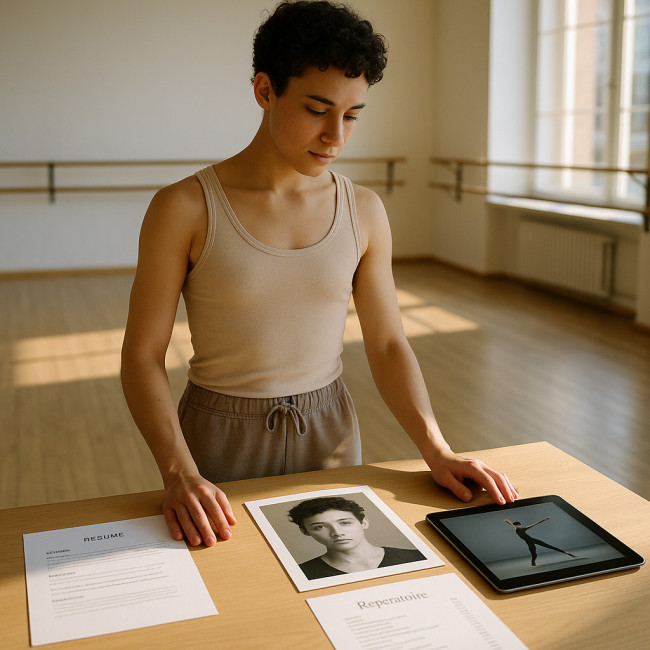Dance casting prep: materials, etiquette and realistic scheduling tactics
Nail your next audition by aligning rock-solid materials, impeccable etiquette and a schedule that respects both your body and the casting team's calendar. Follow this roadmap to turn invitations into repeat contracts.
1. Gather bullet-proof casting materials

From the instant a recruiter's brief pings your inbox to the moment you hit “Send” on your submission, every document you compile acts as a silent ambassador of your professionalism. Picture the packet as a three-dimensional elevator pitch: the headshot announces stage presence, the résumé links past roles to concrete dates like GPS pins, the repertoire sheet maps stylistic versatility, while crystal-clear stills and a punchy video speak when you cannot be in the room. Panels may scan hundreds of profiles per hour, so micro-decisions—font choice, filename syntax, margin width—determine whether your application is shortlisted or sidestepped. Strive for ruthless clarity: one click, one glance, one unmistakable impression that whispers, “Book me now.”
Update your dancer résumé and repertoire list
Your résumé must fit on one page, feature a recent headshot and highlight current height, clothing sizes and passport validity. Keep the repertoire list separate so casting directors can skim roles in seconds.
Craft a bite-sized showreel
A 60- to 90-second reel outperforms longer cuts in recruiter analytics. Open with your strongest ten seconds and close on a contrasting style. Check video compression guidelines in these 2025 self-tape standards to avoid playback glitches.
Supply clear stills
- One full-body neutral pose
- One dynamic action shot
- Close-up headshot
All JPEGs should be under 1 MB, 300 dpi and labelled Name_Role_Year.jpg to stay searchable inside casting databases.
Pre-fill administrative paperwork
Complete W-8/W-9, emergency contact and union status forms ahead of time. A pre-scanned PDF folder speeds up onboarding and signals professionalism.
2. Audition etiquette that wins callbacks
Arrival protocol
Aim to arrive 30 minutes early. Use the first 15 to warm up quietly and the second 15 to observe room flow. If the panel is behind schedule, respect the queue—chatting loudly can cost you points.
Wardrobe cues
Default to solid colours that outline body lines—black for contemporary, jewel tones for jazz, pink or skin-tone tights for ballet. Avoid logos unless the brief requests branded gear.
Communication style
Address the panel collectively (“Good morning, team”). After dancing, thank them, collect your belongings swiftly and exit without lingering. When you must follow up, keep e-mails under 120 words and attach only the file they requested.
Inclusivity matters
Casting houses increasingly favour dancers who demonstrate awareness of diverse collaborators. Brush up on inclusive casting etiquette so you can respond confidently if the panel raises accessibility topics.
3. Build a realistic audition schedule
Reverse-engineer from the performance date
Work backward from the first rehearsal, adding buffer days for travel, costume fittings and potential re-shoots for virtual submissions hosted on Artfolio's collaboration board.
| Task | Ideal start | Latest cut-off |
|---|---|---|
| Update résumé & headshots | 6 weeks out | 4 weeks out |
| Film new showreel clips | 5 weeks out | 3 weeks out |
| Book travel & lodging | 4 weeks out | 2 weeks out |
| Conditioning & injury check | Daily | 48 h before |
| Paperwork & union docs | 3 weeks out | 1 week out |
Factor in digital visibility deadlines
Many panels shortlist online before inviting in-person rounds. Upload fresh content at least 10 days before an open call; directory algorithms favour recent uploads.
Block recovery windows
Schedule active recovery—stretch classes, physiotherapy or ice baths—48 hours after each major audition. Skipping this step increases injury risk and delays future bookings.
4. Smart reminders to keep you on track
- Use calendar colour-coding: red for travel, blue for rehearsals, green for self-tapes.
- Set phone alarms two days before each document deadline.
- Sync time zones when booking virtual callbacks; see geo-targeting tips to avoid clock mishaps.
5. Common pitfalls and quick fixes
Overstuffed schedule
Problem: back-to-back auditions leave no time for rehearsal prep.
Solution: cap in-person auditions to three per week and fill gaps with remote submissions.
Outdated files circulating online
Problem: old reels show hair colours or skill levels that no longer match.
Solution: replace outdated files every quarter, then push the update via profile-scanning tools.
Ignoring casting notes
Problem: sending a jazz combo clip when the brief requested ballet.
Solution: label folders clearly and double-check the call sheet before exporting media.
Checkpoint Quiz: are you audition-ready?
FAQ
- What file format do casting directors prefer for video submissions?
- H.264 MP4 at 1080p is the current industry standard; it balances quality and manageable file size.
- Can I reuse the same headshot for different dance genres?
- Yes, provided it is a neutral look. Genre-specific shots can be added as supplements but are not mandatory.
- How many auditions per day are considered healthy?
- Limit to two substantial auditions daily to avoid fatigue-related mistakes and injuries.
- Is it acceptable to ask for feedback after a rejection?
- Absolutely—send a concise, polite email thanking the panel and requesting one actionable tip for improvement.
Wrap-up: turn preparation into contracts
Polished materials, respectful etiquette and a schedule grounded in reality create a loop of trust between you and casting teams. Download your calendar template, update your reel and lock in recovery time before the next open call lands in your inbox.
Ready to showcase your refreshed profile? Upload your new reel today and position yourself for 2025's most exciting stages.











